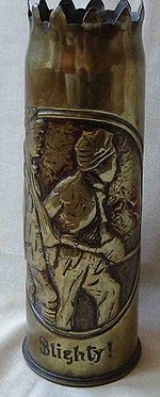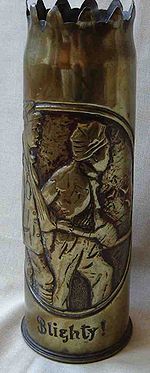
Trench art
Encyclopedia

Common articles that this includes are decorated shell and bullet casings and items carved from wood and bone.
To the uninitiated, all trench art, by definition, was made by a soldier sitting in a trench in France during the First World War, in the midst of a bombardment. To the cynics, it was all made in the 1920s by enterprising French and Belgian citizens. The reality is, naturally, a mix of these extremes, and everything in between, and spans conflicts from the Napoleonic Wars to the present day.
Although the practise flourished during World War I, the term 'trench art' is also used to describe souvenirs manufactured by service personnel during World War II. Some items manufactured soldiers, prisoners of war or civilians during earlier conflicts have been retrospectively described as trench art.
Categorisation
There are four broad categories, four circumstances under which trench art items were created:(Please Note: Check with your national government to obtain an opinion regarding if they believe that 'Trench Art' falls foul of an 'articles of war' definition as promoted by the United Nations. This will have a material impact on your ability to freely trade in these articles. Many governments in their enthusiasm to please have placed a distorted interpretation on these innocuous items and as such border controls are enforced often without notification of the destruction of personal property nor providing compensation.)
Category 1: Soldier-made items
Despite the cynics, there is much evidence to prove that some trench art was made in the trenches, by soldiers, during the war.In With a Machine Gun to Cambrai, George Coppard
George Coppard
Corporal George Coppard was a British soldier who served with the Machine Gun Corps during World War I. Following his retirement he published his memoirs entitled With A Machine Gun to Cambrai in 1969.-Early years:...
talks about pressing his regimental buttons into the clay on the floor of the trench, then pouring molten lead from shrapnel balls into this impression to make lead replicas of the crest – trench art personified.
Chalk carvings were also popular, with contemporary postcards showing carvings into the side of rocky outcrops around dug-outs etc, which again confirm their existence in the battle zone.
Alongside items that, by their nature, had to be made in situ, it is fair to assume many smaller items—rings, paper knives, etc.--were made by soldiers either in front line or support trenches, especially in quieter parts of the line.
In addition, wounded soldiers would be encouraged to do certain craftwork as part of the recuperation process, with embroidery and simple forms of woodwork being common. Again from With a Machine Gun to Cambrai, George Coppard recalls that, while recuperating from wounds at a private house in Birkenhead, “one kind old lady brought a supply of coloured silks and canvas and instructed us in the art of embroidery. A sampler which I produced under her guidance so pleased her that she had it framed for me.”.
Category 2: POW and Internee items
The second category consists of items made by prisoners of war and interned civilians.Since Napoleonic times POWs had good reasons to create decorative objects – unending days with little to occupy them and limited food and money. Much POW work was therefore done with the express intention of trading the finished article for food, money or other privileges.
Reference to POW work is made in the recollections of A B Baker, W.A.A.C., contained in the book Everyman at War, published by Purdom in 1930:
“Part of my work had to do with prisoners quartered in a camp near to our own. Those Germans were friendly men. They were clever with their hands, and would give me little carvings which they had made.”
Category 3: Civilian-made items
The third category is items made by civilians, which mainly means civilians in and around the conflict zone, but would also include items made by sweethearts at home.In 1914 America set up a Belgian Relief Fund, headed by Herbert Hoover
Herbert Hoover
Herbert Clark Hoover was the 31st President of the United States . Hoover was originally a professional mining engineer and author. As the United States Secretary of Commerce in the 1920s under Presidents Warren Harding and Calvin Coolidge, he promoted partnerships between government and business...
. They shipped over staple foodstuffs, mainly flour sent in the printed cotton flour sacks typical of the period. In thanks the Belgians would embroider and paint in the designs, elaborating them with dates and flags, etc., and send them back to America. Many of these are now in the Herbert Hoover Museum in Iowa, but some were sold to soldiers in Paris or given as gifts to individuals involved in the shipment process.
Civilians in France, in the zones occupied by troops, were quick to exploit this new market. Embroidered postcards were produced in what quickly became a cottage industry, with civilians buying the surrounds and embroidering the panel of gauze. These postcards often had regimental crests or patriotic flags and national symbols in abundance, and millions were produced over the course of the war.
When the war ended and civilians began to reclaim their shattered communities, a new market appeared in the form of pilgrims and tourists. Over the ensuing twenty years the mountains of discarded debris, shell casings and equipment were slowly recycled, with mass-produced town crest motifs being stuck onto bullets, shell casings, fuse caps—anything—and sold to tourists.
Category 4: Commercial-made items
The fourth category is purely commercial production. After the war, tonnes of surplus materials were sold by the government and converted to souvenirs of the conflict.Ship breaking, particularly if the ship had been involved in significant events, such as Jutland, resulted in much of the wood from the ship being turned into miniature barrels, letter racks, boxes, etc., with small brass plaques announcing "Made from teak from HMS XYS, whose guns relieved Ladysmith / fought at the battle of Jutland", etc.
External links
- Trench art of World War I
- The UK Trench Art Site
- Trench art of WW1
- WW1 Trench Art http://www.artisanat-de-tranchees.fr/accueil-22.html http://www.souvenirsdelagrandeguerre.com

